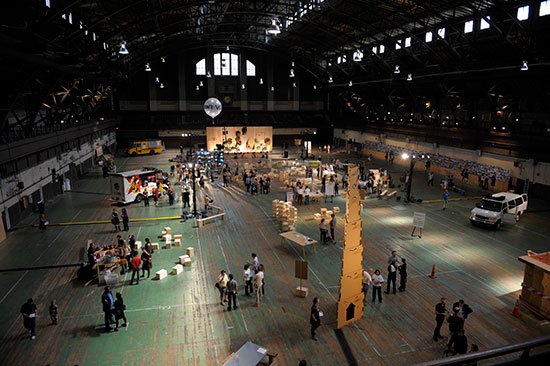The present essay is a slightly amended excerpt from Strike Art: Contemporary Art and the Post-Occupy Condition (Verso). The book treats the eruption of Occupy Wall Street in the fall of 2011 as what Alain Badiou would call a “political truth-event,” one of four such kinds of event whose service as objects of fidelity fundamentally defines the terrain of subjectivity. The ongoing ramifications of Occupy are evident across the spectrum of the Left, ranging from the invocation of the “1 percent” as a general class enemy in the self-described democratic socialist campaign of Bernie Sanders, to the rich debates concerning questions such as the party-form, communization, and platform cooperativism in contemporary theory—all of which have been recoded and radicalized by the emergence of Black Lives Matter.The advent of Occupy has also had deep consequences for contemporary art. First, Occupy was a movement with artists at its core, not just as adjunct decorators, but as organizers, theorists, and propagandists working to articulate their own class composition of indebted, precarious cultural workers with a broader horizon of solidarity with the internally fraught figure of the “99 percent.” Second, the activity of artists in Occupy was decidedly autonomous from the institutions of the art system, even as the latter would become targets of mobilization in their own right by groups such as Occupy Museums, Arts and Labor, GULF, and Not an Alternative. This particular excerpt offers an historical snapshot at the moment of breakage between the institutional art system and the new space opened by Occupy.
Nato Thompson, “Exhausted? It Might be Democracy in America,” in A Guide to Democracy in America, ed. Thompson (New York: Creative Time Books, 2008), 14–25.
Holland Cotter, “With Politics in the Air, a Freedom Free-for-All Comes to Town,” New York Times, September 22, 2008.
See Springtime: The New Student Rebellions, eds. Clare Solomon and Tania Palmieri (Brooklyn: Verso, 2011).
See Living as Form: Socially Engaged Art, ed. Nato Thompson (New York: Creative Time Books/MIT Press, 2012).
Claire Bishop, “Participation and Spectacle: Where Are We Now?” in ibid., 34–55. This text draws on her earlier edited anthology of writings and documents from the twentieth century concerning these questions, Participation (Cambridge, MA: Whitechapel/MIT Press, 2005), and forms the basis for her authoritative summary and critique in Artificial Hells: Participatory Art and the Politics of Spectatorship (Brooklyn: Verso, 2012).
Brian Holmes, “Eventwork: The Fourfold Matrix of Contemporary Social Movements,” in Living as Form, 72–93.
Dan Wang, personal correspondence; also see Wang, “From One Moment to the Next, Wisconsin to Wall Street,” transveral, October 4, 2011 →.
Michael Taussig, “I’m So Angry I Made a Sign,” in Occupy: Three Inquiries on Disobedience (Chicago: University of Chicago Press, 2013), 3.
See T. J. Demos, “Means Without Ends: Ayreen Anastas and Rene Gabri’s Camp Campaign,” October 126 (Fall 2008): 69–90; Nato Thompson, “Conversation with Ayreen Anastas and Rene Gabri,” in A Guide to Democracy in America, 135–138.
“Bah Humbug: Stock Exchange Grinches Can’t Bear Christmas Gift Bull,” New York Post, December 16, 1989. For a detailed history of the sculpture—including its reiteration in other sites around the world such as Shanghai—see chargingbull.com →.
For a pre-Occupy collection of voices from these global struggles, see Springtime.
See Research and Destroy, “Communiqué from an Absent Future,” in Springtime; also Communization and Its Discontents, ed. Benjamin Noys (Brooklyn: Minor Compositions/Autonomedia, 2011); and especially Daniel Marcus’s “From Occupation to Communization,” Occupy Gazette 3 (December 2011) →.
See Rachel Singer, “The New School in Exile, Revisited,” Occupy Gazette 3.
See Anna Feigenbaum, Fabian Frenzel, and Patrick McCurdy, Protest Camps (London: Zed Books, 2014). The authors focus mostly on European examples, but their analysis of the basic elements of the camp as a “biopolitical assemblage” and “collective infrastructure” is highly relevant to understanding both Tahrir and OWS as something more than a matter of liberal public assembly. For a close architectural reading of the encampment set up by the group Hog Farm at the 1972 United Nations Conference on the Human Environment, see Felicity D. Scott, “Wood-Stockholm,” in Sensible Politics: The Visual Culture of Nongovernmental Activism, eds. Yates McKee and Meg McLagan (New York: Zone Books, 397–428).
Alain Badiou, The Rebirth of History: Times of Riots and Uprisings (Brooklyn: Verso, 2012).
For an early instance of critical anxiety around the accelerating travel-flows of the global art system, see Miwon Kwon, One Place After Another: Site-Specific Art and Locational Identity (Cambridge, MA: MIT Press, 2002).
Michael Hardt and Antonio Negri, Multitude: War and Democracy in the Age of Empire (New York: Penguin Press, 2004).
Walter Benjamin, “The Storyteller,” tr. Harry Zohn, in Illuminations (New York: Schocken Books, 1968), 83–110. In 2009, 16 Beaver developed a program of events at the New Museum called “Project for a Revolution in New York; or, How to Arrest a Hurricane,” intended to “assemble a possible diagram for a desiring revolutionary machine.”
Andy Kroll, “How Occupy Wall Street Really Got Started,” in This Changes Everything: Occupy Wall Street and the 99% Movement (Oakland: Berret-Koheler, 2011), 16–21. The Spaniards in question were, among others, Luis Moreno-Caballud and Begonia Santa-Cecillia, who would go on to form the Making Worlds working group in Occupy, devoted to theorizing and experimenting with models of the commons.
See David Graeber’s account of the August 2 assembly in The Democracy Project: A History, a Crisis, a Movement (New York: Spiegel & Grau, 2013), 24–30; and Nathan Schneider’s account of the weeks of meetings leading up to the September 17 occupation in Thank You, Anarchy: Notes from the Occupy Apocalypse (Berkeley: UC Press, 2013).
Martha Rosler, “The Artistic Mode of Revolution: From Gentrification to Occupation,” eflux journal 33 (March 2012) →.
